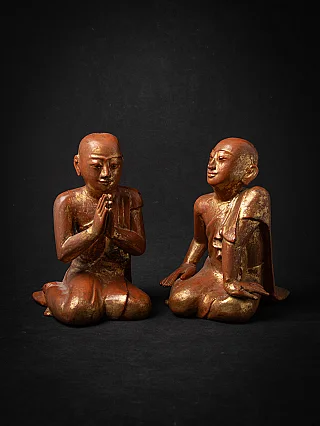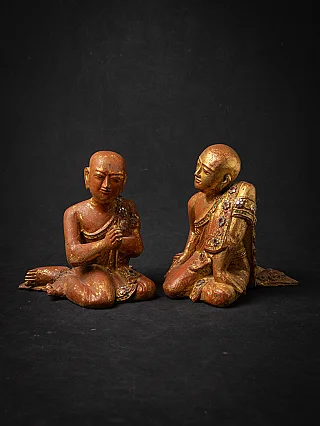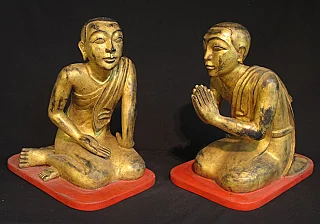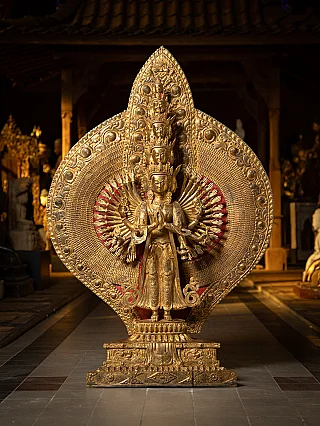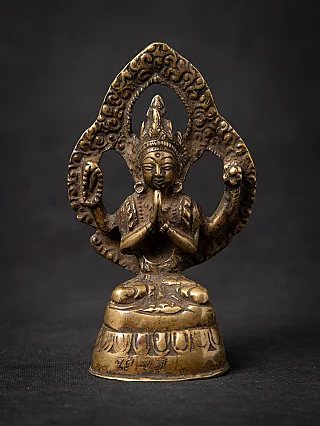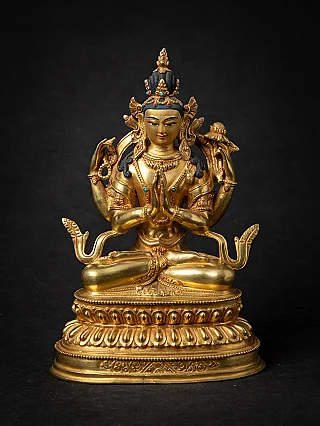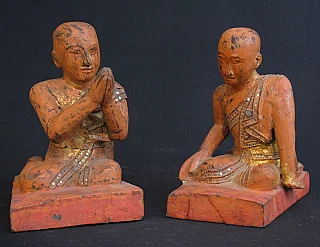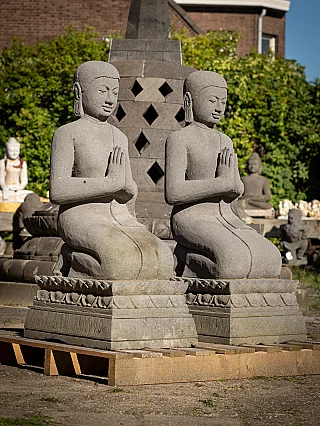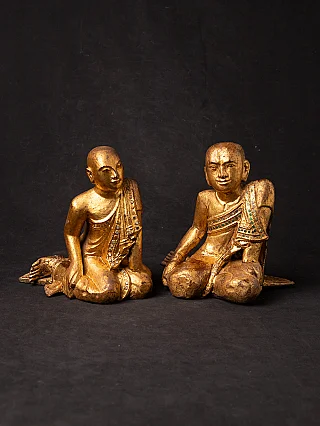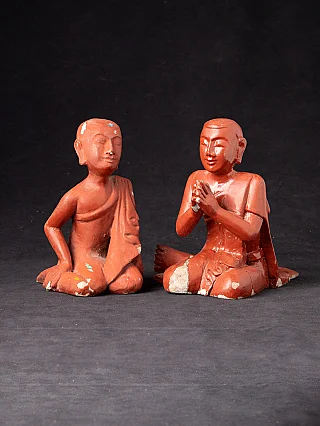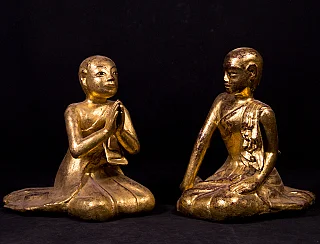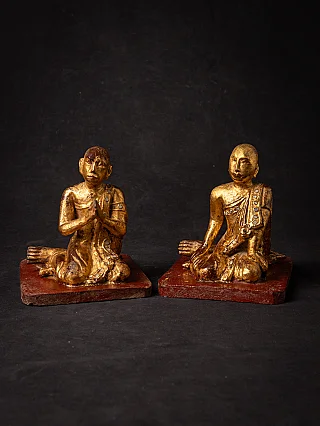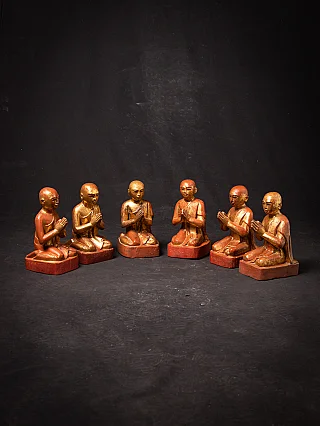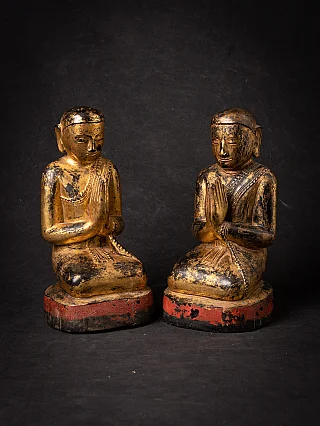Namaskara Mudra

See our statues with the Namaskara mudra
Namaskara Mudra, also known as Anjali Mudra or Pranamasana, is one of Buddhism's most widely recognized and universally practiced gestures. This simple yet profound gesture involves pressing the palms together in front of the chest, with the fingers pointing upwards. It is commonly seen in various religious and social contexts, symbolizing respect, gratitude, and humility. The gesture of Namaskara is practiced throughout many Asian countries. It is a sign of respect and greeting in Nepal, India, Sri Lanka, Burma, Thailand, and others. This gesture is used in many yoga asanas, too. Mudra means "seal" or "sign," and the translation or meaning of the phrase "Anjali Mudra" is "salutation seal" or a "greeting seal." This mudra is also known as the Hridayanjali Mudra, which means admiration for the heart seal from the soul.
Historical and Cultural Significance
Origins in Ancient Buddhist Traditions

Namaskara Mudra has its roots in ancient Buddhist traditions and has been a significant aspect of Buddhist practices for millennia. The gesture is mentioned in ancient Buddhist texts and is associated with worship, devotion, and spiritual practices. It is prominently featured in Buddhist iconography and rituals, symbolizing reverence and the acknowledgment of the Buddha and other enlightened beings.
Symbolism in Buddhism
- Gesture of Reverence: In Buddhism, Namaskara Mudra is a familiar gesture of reverence towards the Buddha, bodhisattvas, and fellow practitioners. It signifies humility, respect, and the unity of mind and body.
- Spiritual Connection: The gesture represents the connection between the practitioner and the divine. Bringing the hands together at the heart center acknowledges spiritual unity and interconnectedness.
- Bodhisattva Vows: Namaskara Mudra is often used during the recitation of the Bodhisattva vows, symbolizing the practitioner's commitment to compassion, wisdom, and enlightenment for the benefit of all sentient beings.
Contemporary Use in Buddhism
Namaskara Mudra transcends religious and cultural boundaries. It is used globally in various contexts, such as greeting someone with a respectful "Namaste," expressing gratitude, and even as a gesture of mindfulness and meditation.
Spiritual and Symbolic Meanings
Acknowledging the Buddha Nature
One of the most profound meanings of Namaskara Mudra in Buddhism is recognizing the Buddha's nature within oneself and others. Bringing the hands together at the heart center acknowledges every individual's inherent potential for enlightenment.
Unity and Balance
The symmetry of Namaskara Mudra symbolizes balance and unity. It represents the harmony between the left and right hemispheres of the brain, the union of wisdom and compassion, and the integration of mind, body, and spirit.
Gratitude and Humility
Performing Namaskara Mudra expresses gratitude and humility. It conveys respect and appreciation toward oneself, others, and the universe. It reminds individuals to approach life with a humble heart and appreciation.
Health and Psychological Benefits
- Enhanced Concentration: Pressing the palms together activates the brain's focus centers, improving concentration and cognitive function.
- Improved Posture: Practicing Namaskara Mudra encourages an upright posture, which can help alleviate back and neck pain.
- Blood Circulation: This gesture promotes better blood circulation in the upper body, particularly in the hands and arms.
- Mental and Emotional Benefits
- Stress Reduction: The calming nature of Namaskara Mudra helps reduce stress and anxiety, promoting a sense of peace and relaxation.
- Emotional Balance: By connecting with the heart center, this mudra helps balance emotions and fosters emotional stability.
- Mindfulness and Presence: Performing Namaskara Mudra encourages mindfulness and brings awareness to the present moment, enhancing overall mental clarity.
How to Practice Namaskara Mudra
Step-by-Step Guide
- Find a Comfortable Position: Sit or stand comfortably with your spine straight and shoulders relaxed.
- Bring Your Hands Together: Place your palms together in front of your chest, with your fingers pointing upwards.
- Press Gently: Apply gentle pressure to activate the energy centers in your hands and heart.
- Close Your Eyes (Optional): For a more profound meditative experience, close your eyes and take a few deep breaths.
- Focus on Your Heart Center: Direct your attention to where your hands meet, visualizing a sense of warmth and connection.
- Stay Present: Hold the gesture for as long as you feel comfortable, maintaining a sense of presence and mindfulness.
Integrating Namaskara Mudra into Buddhist Practice
- Morning Ritual: Begin your day with Namaskara Mudra to set an optimistic and mindful tone.
- During Meditation: Use this mudra at the start and end of your meditation session to cultivate gratitude and focus.
- Chanting and Prayers: Incorporate Namaskara Mudra into your chanting and prayer practices to deepen your sense of connection and reverence.
- Greeting Others: Use this gesture as a respectful and heartfelt way to welcome others in your community, saying "Namaste" or "Namaskar."
Detailed Performance of Namaskara Mudra
Commonly, Namaskara Mudra is performed with the hands held at the heart chakra and the thumbs resting lightly against the sternum. This position enhances the connection to love, compassion, and gratitude. Alternatively, the mudra can be performed at the brow chakra with the tips of the thumbs resting against the third eye, symbolizing inner wisdom and spiritual insight.
Vajradhatu and Garbhadhatu Realms
In Buddhist iconography, Namaskara Mudra is the union of two realms: the Diamond Realm (Vajradhatu) and the Matrix Realm (Garbhadhatu). These realms represent the two facets of one spiritual life and portray the reciprocal action of the spiritual and material worlds.
Why Buddha Statues Don't Depict Namaskara Mudra
One might wonder why Buddha statues rarely depict the Namaskara Mudra despite its profound significance in Buddhist practices. The answer lies in the unique nature of the Buddha's enlightenment. Having attained supreme enlightenment, the Buddha embodies the ultimate state of spiritual realization and unity with the divine. In this state, the Buddha transcends the need for gestures of devotion or supplication, such as Namaskara Mudra.
Buddha statues are typically depicted in mudras that convey specific aspects of his teachings and enlightenment, such as the Dharmachakra Mudra (teaching), Bhumisparsha Mudra (earth witness), and Abhaya Mudra (fearlessness). These mudras highlight the Buddha's role as a teacher, protector, and enlightened being rather than a devotee.
Stories and Anecdotes
A Tale of Humility and Reverence
One ancient tale from Buddhist mythology tells the story of a monk who used Namaskara Mudra to greet and seek blessings from the Buddha. This gesture of humility and respect endeared him to the Buddha and highlighted the importance of acknowledging the divine in everyone.
Modern-Day Applications
In contemporary settings, Namaskara Mudra is often used in mindfulness practices and corporate wellness programs. After incorporating this gesture into their daily routines, Many report feeling more centered, focused, and connected.
Share this page



















